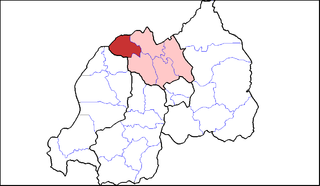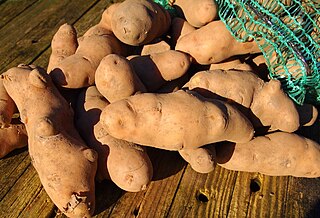Related Research Articles

The potato is a starchy tuber of the plant Solanum tuberosum and is a root vegetable and a fruit native to the Americas. The plant is a perennial in the nightshade family Solanaceae.

Phytophthora infestans is an oomycete or water mold, a fungus-like microorganism that causes the serious potato and tomato disease known as late blight or potato blight. Early blight, caused by Alternaria solani, is also often called "potato blight". Late blight was a major culprit in the 1840s European, the 1845 - 1852 Irish, and the 1846 Highland potato famines. The organism can also infect some other members of the Solanaceae. The pathogen is favored by moist, cool environments: sporulation is optimal at 12–18 °C (54–64 °F) in water-saturated or nearly saturated environments, and zoospore production is favored at temperatures below 15 °C (59 °F). Lesion growth rates are typically optimal at a slightly warmer temperature range of 20 to 24 °C.

Mashed potato, mashed potatoes or mashed taters, colloquially known as mash, is a dish made by mashing boiled potatoes, usually with added milk, butter, salt and pepper. It is generally served as a side dish to meat or vegetables. When the potatoes are only roughly mashed, they are sometimes called smashed potatoes. Dehydrated instant mashed potatoes and frozen mashed potatoes are available. Mashed potatoes are an ingredient in other dishes, such as dumplings and gnocchi.
Bloomer may refer to:

Ullucus is a genus of flowering plants in the family Basellaceae, with one species, Ullucus tuberosus, a plant grown primarily as a root vegetable, secondarily as a leaf vegetable. The name ulluco is derived from the Quechua word ulluku, but depending on the region, it has many different names. These include illaco, melloco, chungua or ruba, olluco or papalisa, or ulluma.

Potato bread is a form of bread in which potato flour or potato replaces a portion of the regular wheat flour. It is cooked in a variety of ways, including baking it on a hot griddle or pan, or in an oven. It may be leavened or unleavened, and may have a variety of other ingredients baked into it. The ratio of potato to wheat flour varies significantly from recipe to recipe, with some recipes having a majority of potato, and others having a majority of wheat flour. Some recipes call for mashed potatoes, with others calling for dehydrated potato flakes. It is available as a commercial product in many countries, with similar variations in ingredients, cooking method, and other variables.

Russet Burbank is a potato cultivar with dark brown skin and few eyes that is the most widely grown potato in North America. A russet type, its flesh is white, dry, and mealy, and it is good for baking, mashing, and french fries (chips). It is a common and popular potato.

Agriculture in Cuba has played an important part in the economy for several hundred years. Today, it contributes less than 10% to the gross domestic product (GDP), but it employs about 20% of the working population. About 30% of the country's land is used for crop cultivation.

Musanze is a district in the Northern Province of Rwanda. Its capital city is Ruhengeri, Musanze is the fourth largest town in Rwanda and is quickly growing into a bustling metropolis. Musanze district is one of thirty districts in all of Rwanda and one of five districts in the Northern Province.

Amflora is a genetically modified potato cultivar developed by BASF Plant Science. "Amflora" potato plants produce pure amylopectin starch that is processed to waxy potato starch. It was approved for industrial applications in the European Union on 2 March 2010 by the European Commission. In January 2012, the potato was withdrawn from the market in the EU.
Mizen is a high-yielding creamy yellow skinned potato that produces long, smooth-skinned tubers with good resistance to foliar and tuber blight. Flesh is white with medium dry-matter content. Mizen is one of the potato varieties bred in the 1970s at Teagasc Oak Park breeding centre in County Carlow, Ireland.
British Queen is a variety of potato that was bred by Archibald Finlay.
Black Champion is a variety of potato with purple skin colour that produces round, flattened tubers. Davidson (1936) described this as an old variety found growing in the Midlands of Ireland but of no commercial value. Noted by Kehoe (1986) as being unique to the Irish potato collection.
Skerry Champion is a variety of potato with a round-to-oval shape and creamy yellow skin with a beautiful blue/purple "birthmark" colouring. 'Skerry Champions' have only recently become available to growers again after a long period of absence due to a host of viral diseases it was carrying. Taste quality is excellent with a lovely flavour and floury texture. They are quite highly resistant to blight however the tops of diseased haulms should be removed to keep tubers healthy. It has also been known as Buchan Beauty and although introduced into Ireland in 1922, may have existed in the UK before then.

Irish White is a variety of potato that was traditionally grown in County Donegal and Antrim. It was raised by Robert Christie of Ballytaggart about 1882.
The Ulster Emblem variety of potato originated in Northern Ireland. It was originally bred by Mr J. Clarke of Ballymoney, Co. Antrim. It has a long oval shape with white skin and flesh which has a semiwaxy texture, reasonable flavour with good cooking quality, and a fairly good yield. This variety has a red violet coloured flower and a pink sprout colour. It also has a high resistance to late blight on the tubers as well as the plant foliage.

The Pink Fir Apple potato is a maincrop potato variety with a long knobbly shape, pink skin, and creamy waxy flesh. Its shape makes it difficult to peel.
Champion is a potato variety bred by John Nicoll in Scotland and widely grown in Ireland during the latter half of the 19th century. The tuber is round, with white skin and yellow flesh. The texture is described as "floury".

The potato was the first domesticated vegetable in the region of modern-day southern Peru and extreme northwestern Bolivia between 8000 and 5000 BCE. Cultivation of potatoes in South America may go back 10,000 years, but tubers do not preserve well in the archaeological record, making identification difficult. The earliest archaeologically verified potato tuber remains have been found at the coastal site of Ancón, dating to 2500 BC. Aside from actual remains, the potato is also found in the Peruvian archaeological record as a design influence of ceramic pottery, often in the shape of vessels. The potato has since spread around the world and has become a staple crop in most countries.
Nigeria is one of the largest producers of potatoes in Africa. The potato was introduced to the country in the 19th century by Christian missionaries and is largely cultivated in the central region of the country in Plateau State.
References
- ↑ Irish seed savers 2010 seed catalogue
- ↑ "Potato Varieties of Historical Interest in Ireland" (PDF). Ireland's Department of Agriculture, Fisheries and Food. Archived from the original (PDF) on 21 June 2013. Retrieved 14 January 2011.
